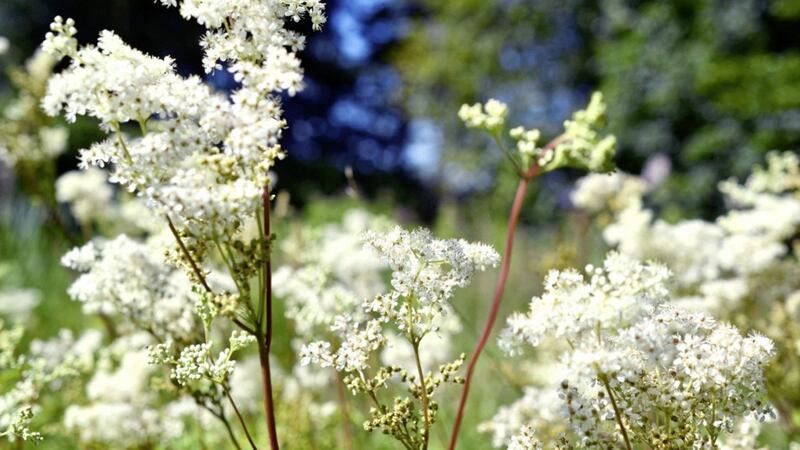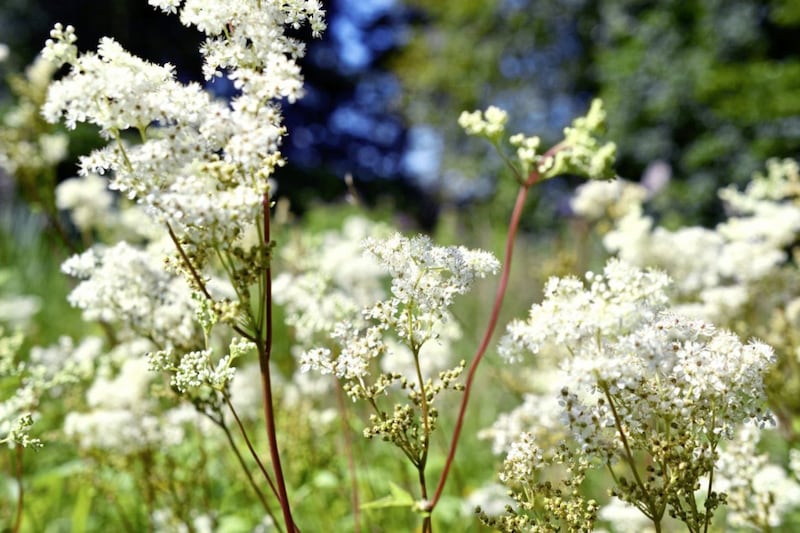DURING the summer weeks of July, most of our adult birds have fallen silent. Tired and dishevelled from the busyness of chick rearing, they begin to moult, replacing old feathers with a new set to provide effective insulation for the winter ahead.
Many of our wildflowers have also passed their peak as a calmness or ‘suaimhneas’ descends on the natural world. There are, however, still many delights to observe, like meadowsweet, the creamy perennial flower presently standing tall in our damp waysides and marshes, with its heavily fragranced and densely clustered flowers on long, reddish-tinged stems.
Filipendula ulmaria, or Spirea ulmaria as it was previously known, has dark green, long stalked and pinnate leaves with pale undersides. It flowers from late June through August and sometimes into September.
The first part of the botanical name, Filipendula, means 'hanging (pendulus) on a thread (filum)' and refers to the root tubers which hang on fibrous roots. The second name, ulmaria, means 'elm like' and while there is no obvious resemblance to the elm tree (Ulmus), in common with the bark of the slippery elm tree (Ulmus rubra), meadowsweet contains salicylic acid which has long been used as a painkiller.
In the 19th century chemists isolated salicylic acid from the flower, created a synthetically altered version, formally acetylsalicylic acid, and sold it in tablet form as ‘aspirin’ – ‘a’ for acetyl and ‘spirin’ for Spirea, the original Latin name for meadowsweet.
Meadowsweet’s long history of use by humans as a healing herb and a sweet-smelling plant has ensured a rich repository of fascinating history and folklore exists around the plant. Archaeological digs of prehistoric graves in a Bronze Age cairn at Fan Foe, west Wales have found traces of meadowsweet with the cremated remains of three people and at least one animal.
It is thought these may indicate burial with honey-based mead or flavoured ale placed with food as nourishment for the onward journey of the deceased.
Its English name originates from the Anglo-Saxon Meodu-swete meaning ‘mead sweetener’ as it has been used to flavour mead, beer, wine and other drinks from early times. The many names given to meadowsweet point to its various uses through time. Named ‘queen of the meadow’, it was popular as a strewing herb, mixed with rushes to give warmth underfoot and to overcome smells and infections, reputedly a favourite herb of Queen Elizabeth I for that purpose.
The less complimentary Yorkshire name of ‘courtship and matrimony’ highlights the sweet honey aroma of the flowers as representing courtship and the sharper, more bitter scent of the crushed foliage as the reality of marriage.
It acquired the name bridewort because it was strewn on the ground at ‘handfastings’, pagan-type weddings, for the bride to walk on, and also for its use in posies and bridal bouquets.
According to Irish Legend, it was the land goddess of Munster, Áine, who gave meadowsweet its fragrance. Cúchulainn was supposedly given the plant in liquid form to help calm his fits of rage and fever, a possible explanation for one of its Irsih names, Crios Conchulainn (Cúchaliann’s Belt).
Although Maud Grieve states it was a herb held sacred by the Druids (A Modern Herbal: 1931), it seems most pagan cultures used the plant primarily for medicine and as a perfume rather than for religious ritual.
Ballyshannon poet William Allingham, on the flower’s virtues wrote:
Through grass, through amber’d cornfields, our slow stream
Fringed with its flags and reeds and rushes tall,
And Meadowsweet, the chosen of them all
By wandering children, yellow as the cream
Of those great cows



